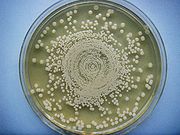
Mueller-Hinton agar
Encyclopedia

Growth medium
A growth medium or culture medium is a liquid or gel designed to support the growth of microorganisms or cells, or small plants like the moss Physcomitrella patens.There are different types of media for growing different types of cells....
that is commonly used for antibiotic susceptibility
Antibiotic resistance
Antibiotic resistance is a type of drug resistance where a microorganism is able to survive exposure to an antibiotic. While a spontaneous or induced genetic mutation in bacteria may confer resistance to antimicrobial drugs, genes that confer resistance can be transferred between bacteria in a...
testing. It is also used to isolate and maintain Neisseria
Neisseria
The Neisseria is a large genus of commensal bacteria that colonize the mucosal surfaces of many animals. Of the 11 species that colonize humans, only two are pathogens. N. meningitidis and N. gonorrhoeae often cause asymptomatic infections, a commensal-like behavior...
and Moraxella
Moraxella
Moraxella is a genus of Gram-negative bacteria in the Moraxellaceae family. It is named after the Swiss ophthalmologist Victor Morax. The organisms are short rods, coccobacilli or, as in the case of Moraxella catarrhalis, diplococci in morphology, with asaccharolytic, oxidase-positive and...
species.
It typically contains (w/v
Percentage solution
"Percentage solution" is an ambiguous term which is used to describe a solution with the unit "%". It may refer to:* Mass fraction if mass/mass is meant...
):
- 30.0% beef infusion
- 1.75% caseinCaseinCasein is the name for a family of related phosphoprotein proteins . These proteins are commonly found in mammalian milk, making up 80% of the proteins in cow milk and between 60% and 65% of the proteins in human milk....
hydrolysateHydrolysisHydrolysis is a chemical reaction during which molecules of water are split into hydrogen cations and hydroxide anions in the process of a chemical mechanism. It is the type of reaction that is used to break down certain polymers, especially those made by condensation polymerization... - 0.15% starchStarchStarch or amylum is a carbohydrate consisting of a large number of glucose units joined together by glycosidic bonds. This polysaccharide is produced by all green plants as an energy store...
- 1.7% agarAgarAgar or agar-agar is a gelatinous substance derived from a polysaccharide that accumulates in the cell walls of agarophyte red algae. Throughout history into modern times, agar has been chiefly used as an ingredient in desserts throughout Asia and also as a solid substrate to contain culture medium...
- pH adjusted to neutral at 25 °CCelsiusCelsius is a scale and unit of measurement for temperature. It is named after the Swedish astronomer Anders Celsius , who developed a similar temperature scale two years before his death...
.
Five percent sheep blood may also be added when susceptibility testing is done on Streptococcus
Streptococcus
Streptococcus is a genus of spherical Gram-positive bacteria belonging to the phylum Firmicutes and the lactic acid bacteria group. Cellular division occurs along a single axis in these bacteria, and thus they grow in chains or pairs, hence the name — from Greek στρεπτος streptos, meaning...
species. This type is also commonly used for susceptibility testing of Campylobacter
Campylobacter
Campylobacter is a genus of bacteria that are Gram-negative, spiral, and microaerophilic. Motile, with either unipolar or bipolar flagella, the organisms have a characteristic spiral/corkscrew appearance and are oxidase-positive. Campylobacter jejuni is now recognized as one of the main causes...
.

